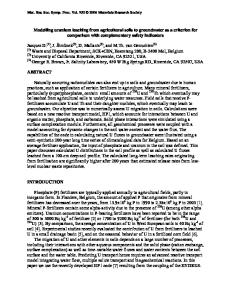Adoption of phytodesalination as a sustainable agricultural practice for improving the productivity of saline soils
- PDF / 686,355 Bytes
- 17 Pages / 439.37 x 666.142 pts Page_size
- 72 Downloads / 308 Views
Adoption of phytodesalination as a sustainable agricultural practice for improving the productivity of saline soils Marcos A. Lastiri‑Hernández1 · D. Álvarez‑Bernal1 · R. Moncayo‑Estrada2 · G. Cruz‑Cárdenas1 · J. T. Silva García1 Received: 25 September 2019 / Accepted: 16 September 2020 © Springer Nature B.V. 2020
Abstract Due to the strong impact of soil salination on the productivity of crops, the implementation of sustainable agricultural practices (SAPs) such as phytodesalination is intended to reverse its effects. While this practice is used in most Middle Eastern countries, Mexico has just begun envisaging its benefits and potential. This study evaluated factors promoting the adoption of phytodesalination among agricultural producers based on the municipality of Villamar, Mexico. Two hundred forty-five semistructured surveys were designed and applied to farmers who participated in various events to disseminate the practice of phytodesalination. Information was gathered on the socioeconomic/demographic characteristics and affectation levels of their parcels due to the effects of salinity. Through a logistic regression using Lasso restriction, the factors influencing the farmers’ decisions to adopt phytodesalination in their specific productive models were evaluated. The results show that more than 87% of the surveyed farmers are male, that their average age is 52 years, that more than 82% have at most an elementary or high school education, that the average plot size in the study area is roughly 4 ha, that more than 76% of the farmers are native to the area and that approximately of 84% use their production exclusively for sales. According to the model employed [prediction of 90% and AUC (area under the curve) of 0.97], the surveyed farmers are mostly influenced by institutional (advice on implementing desalination), organizational (skills and competencies to spread halophyte species in accordance with parcel length and access to halophyte plants) and economic (time to implement phytodesalination) factors. The promotion of this approach and commitment of the region’s various institutions are recommended so that farmers can extend their knowledge of SAPs through a comprehensive strategic approach that allows them to address their specific challenges. Keywords Phytodesalination · Halophyte · Salinity · Logit model
* D. Álvarez‑Bernal [email protected] 1
Instituto Politécnico Nacional, CIIDIR unidad Michoacán, Depto. Investigación, Justo Sierra 28, Centro, 59510 Jiquilpan, Michoacán, Mexico
2
Instituto Politécnico Nacional, CICIMAR, Av. Instituto Politécnico Nacional s/n, Col. Playa Palo de Santa Rita, 23096 La Paz, B.C.S., Mexico
13
Vol.:(0123456789)
M. A. Lastiri‑Hernández et al.
1 Introduction In the last few decades, increasing attention has been paid to factors related to the adoption of new agricultural practices, especially in developing countries, where increasing salinity is a limiting environmental factor that affects and restricts the production of agricultural crops and renders
Data Loading...











